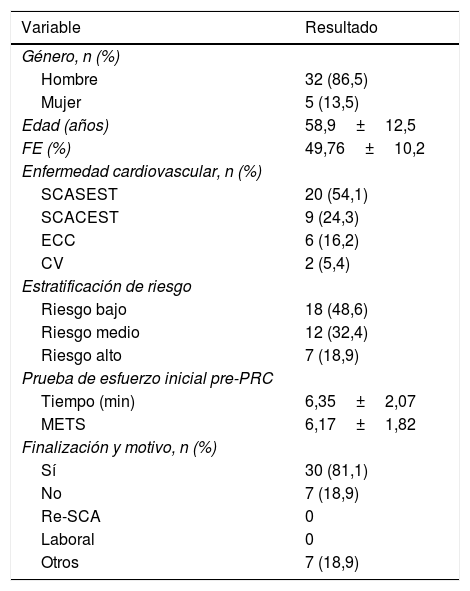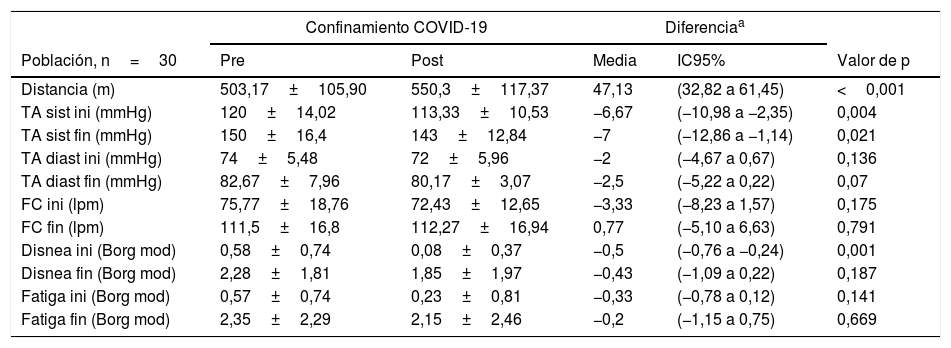La rehabilitación cardíaca tiene el máximo nivel de evidencia en las guías médicas de referencia. Estudiamos los efectos de un programa interdisciplinar dirigido mediante telemedicina tras síndrome coronario agudo en prevención secundaria fase ii en periodo de confinamiento por COVID-19.
MétodosEntre el 2 y 11 de marzo de 2020 se incluyeron 37 pacientes predominantemente con cardiopatía isquémica estable (76,4%) y función sistólica preservada sometidos a tratamiento 12 semanas. Se aplicó un programa de entrenamiento de tonificación muscular dinámico con sobrecarga domiciliario, además de asesoramiento nutricional y terapia psicológica y educativa mediante telemedicina.
ResultadosDe la cohorte inicial, finalizaron 30 pacientes. La capacidad funcional aumentó en la prueba de marcha de seis minutos (47,13m; IC95% 32,82 a 61,45; p<0,001), donde se produjo también un descenso de la sensación subjetiva de disnea inicial (−0,5unidades; IC95% −0,76 a −0,24; p=0,001) en la escala de Borg modificada y de la tensión arterial sistólica inicial (−6,67mmHg; IC95% −10,98 a −2,35; p=0,004) y final (−7mmHg; IC95% −12,86 a −1,14; p=0,021). Se observó un aumento del nivel de actividad física en el tiempo de ocio en el IPAQ (1162,93min/semana; IC95% 237,36 a 2088,5; p=0,016) y mejoraron los hábitos alimentarios mediterráneos en el test PREDIMED (2,1unidades; IC95% 1,32 a 2,28; p<0,001).
ConclusionesLos pacientes que realizaron 3 meses de rehabilitación cardíaca domiciliaria aumentaron la capacidad funcional y mejoraron los hábitos higiénico-alimentarios, además disminuyeron su sensación de disnea inicial. La rehabilitación cardíaca domiciliaria mediante telemedicina produce una mejoría del paciente tras sufrir síndrome coronario agudo.
Cardiac rehabilitation has the highest level of recognition in medical guideline references. The rise of COVID-19 pandemic, particularly during the first months of strict containment, cause to temporally stop most of the ongoing programs. We studied the effects of an interdisciplinary phase II secondary prevention in patients diagnosed with a recent acute coronary syndrome with the use of new technologies, home-exercise and telemedicine.
MethodsBetween the 2nd and 11th of March 2020, we included 37 patients with recent acute coronary syndrome (76.4%), low-risk and preserved systolic function and underwent a 12-week treatment. A dynamic muscle toning with overload domiciliary training program was applied, in addition to nutritional counselling, as well as psychological and educational therapy.
ResultsOf the initial cohort, 30 patients finished. At the end of the program, we observed and increased functional capacity over the 6-min walking test (+47.13m; 95% CI: 32.82-61.45, P<.001), and improvement to the subjective feeling of dyspnoea on the modified Borg scale (−0.5 units; 95% CI: −0.76 to −0.24, P=.001), and an improvement over both initial and final training systolic blood pressure (−6.67mmHg; 95% CI: −10.98 to −2.35, P=.004) (−7mmHg; 95% CI: −12.86 to −1.14, P=.021). We also observed an increase in the level of physical activity during leisure time in the IPAQ questionnaire (+1162.93min/week; 95% CI: 237.36–2088.5, P=.016), and in the Mediterranean eating habits on the PREDIMED test (+2.1units; 95% CI: 1.32–2.28, P<.001).
ConclusionsAfter three months of a domiciliary cardiac rehabilitation program, patients increased their functional capacity, feeling of dyspnoea, blood pressure and eating habits. Domiciliary telemedicine cardiac rehabilitation program produces an improvement in the patient after acute coronary syndrome.









